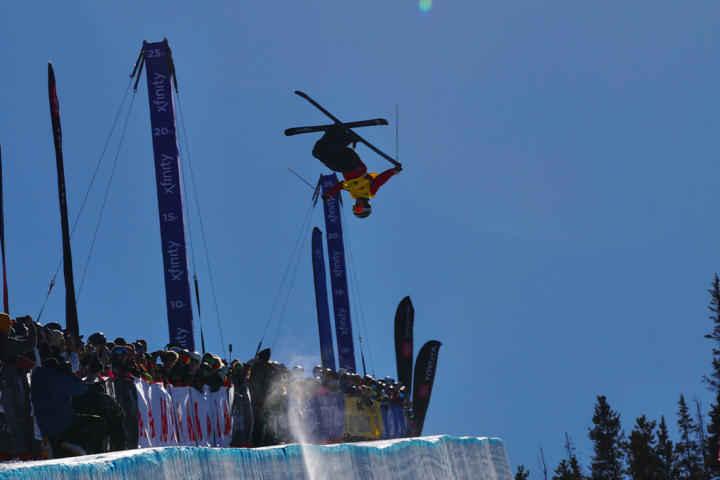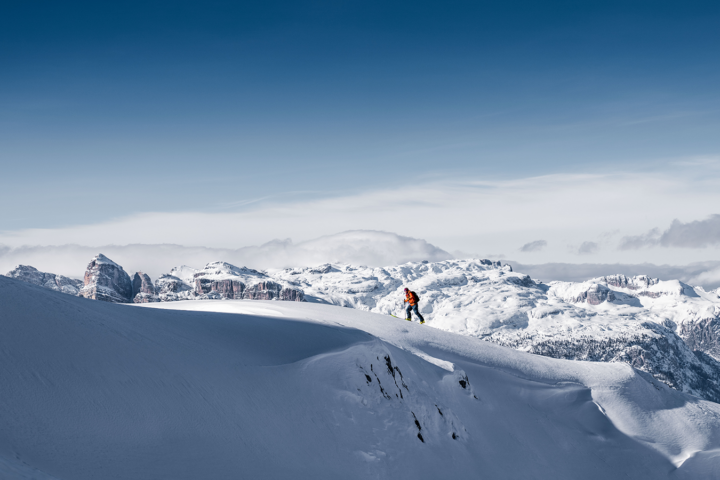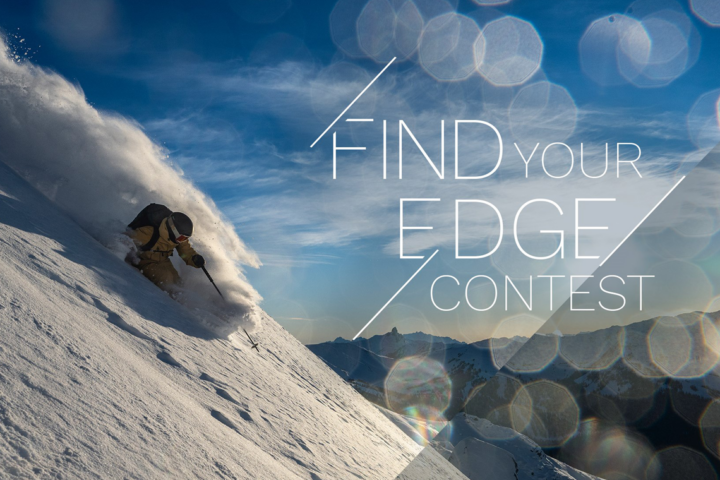Written & Photographed by: Chris O’Connell
The effortless drone of our 1970s Hawker Siddeley plane conitnues as I look out the window at mountains so spectacular they cannot be described and so vast that it almost feels as if the engines aren’t working, but the plane is moving. We’re flying north from Vancouver, toward an old gold-mining runway adjacent to the Bell 2 Lodge, so far north that we’re above the Alaskan panhandle.

Tanner Hall is sitting next to me. He isn’t quiet very often, but he’s just staring out the window at the mountains, probably scoping lines and picking kicker spots. He just won a silver medal at X Games halfpipe, then jumped on a plane to Vancouver right away. He seems utterly relaxed, going from the high-pressure environment of skiing’s largest event straight to a lodge in the middle of nowhere. What a contrast.
This trip started with a phone call on a warm October morning from Oakley Ski Marketing Manager Greg Strokes. He told me we were going to northern BC in February with TGR to shoot Tanner Hall, Dana Flahr, Seth Morrison and Kye Petersen. That’s not a bad phone call to get when you’re planning out the season, but I found myself asking, Last Frontier Heliskiing? My mind conjured up images of a cheesy high-end heli operation that only lets you ski flat pow and takes 12 clients down the same run all at the same time. I was entirely wrong.
The plane descends quickly into a box canyon, coming within spitting distance of the craggy peaks, banks a big turn and lands on a powder runway. The plane bounces a couple times and we slide to a halt. It’s the craziest runway any of us has ever landed on.

Last Frontier Heliskiing operates out of the Bell 2 Lodge, which started as a gas station on the Cassiar Highway that runs all the way to Alaska. You have to stop for gas there, otherwise you won’t make it. Go ahead and type “Bell 2,” into Google Earth and you will immediately understand how remote it is. In 10 years, the Lodge has been transformed from gas station and trailers to five stars, with the addition of workout rooms, individual chalets, and of course a sauna and hot tub complex. While the improvements are a nice bonus, the focus remains on skiing.
In my 15 years as a photographer in the ski industry, I have shot with many of the major fi lm and editorial crews all over the globe. Even though I thought I was a somebody, I was a virgin TGR trip guy. I knew these guys were serious when I received an email from the TGR office saying that I had to have a programmable VHF radio all set up for communications with the helicopter and the rest of the group. Even after five trips to Alaska, I have never had that mandated. My Motorolas from Target were not going to cut it anymore.
Kye Petersen boosts a really lofty, really big 360 into almost fresh tracks. This was one of the last few shots of the trip, right as the shadow line was about to eat the kicker. I was hanging out of the helicopter for this, moving at pretty much the exact same speed as Kye, so it was really trippy shooting this angle.

The phone in my room rings at 3 a.m. I wake up and have no idea where I am. “Chris, our cabin is on fire and you need to get out right away, your room is going to burn down. Seth Morrison is calm and I can smell the Canadian Whisky and Jagermeister through the phone receiver. Todd Jones is laughing and yelling in the background, saying that I should vacate the premises. I can hear him in stereo, through the floor below me and through the receiver. We are two and a half hours from the nearest bar and four hours from the nearest town, but these guys have found the well-stocked bar here at Last Frontier Heliskiing and started the age-old mission of any ski shoot: “Drink it blue.” I sit up out of my deep sleep to make sure I’m not on fire, then hang up and go back to sleep, only to hear Todd singing away a floor below me ‘till the early morning hours. I guarantee his shirt is off.
In the morning we wake up to see that Seth and Todd have succeeded. It’s the break we have been waiting for. It’s game on, and not a single person complains of a hangover (or possibly of still being drunk). When it’s game on for TGR, the hammer goes down and the crew gets it done. I’m a little sleep-deprived, but for once I’m the guy who isn’t hung-over, which was a blessing.
I look around the helicopter as we take off. Todd Jones is in the copilot seat, Kye Petersen is riding bitch and to my right and left are Seth Morrison, Tanner Hall and Dana Flahr. Basically I’m sandwiched by everything that is progressive and important in big-mountain skiing. At the expense of sounding gay, it feels good. These guys are about as no-stress as you can find, and everyone is in it for one thing: shredding powder. There’s nothing wrong with that cliché that powder is the best possible feeling you will ever experience beneath your boards and we are about to go get some work done.

We already have our zone scoped and we fl y right to it, drop athletes on top of their lines, and then pull the helicopter doors off. Legendary filmer and TGR partner Corey Gavitt and Istrap into the side of the heli and got ready for our first “doors off” shot of the trip. CG spits the only thing he has had to eat all morning—a walnut sized Copenhagen breakfast dip—out on the pristine powder and we takeoff.
Having flown over a hundred hours in helicopters, I can tell you one thing: Helicopter pilots have nerves of steel. So when I am hanging out the side of a helicopter on the first run of the day and hear, “Oh shit,†from the pilot in my headphones, I get a little worried.
Jean-Yves, the pilot, gets a little tight to the mountain, and with the cold morning air (-13 Fahrenheit) we stop getting any lift from the rotor blades. The heli starts to descend on top of Kye Peterson. JY, as CG referred to him, keeps it together and peels off the mountainside, not a moment too soon. The “Oh shit” was a quick way to wake us up, that’s for sure.

Later at dinner that night that CG, admits to me when we were getting pulled down that he thought he was going to puke into his balaclava because of the G force and the whiskey from the night before, but other than that, it was business as usual in the mountains for TGR. Not a peep from anyone to let on that they stayed up till 4:30 a.m. the night before. That’s real mountain men for you.
Sitting down with Michael Brackenhofer, the lead guide at The Last Frontier Heliskiing and our guide for the trip, is an interesting experience. He was a high-paid fashion and advertising photographer based out of Munich who shot for small companies like Marlboro and Audi. But he gave it all up to be a heli ski guide. The first thing he tells me when I ask him about the location is mind-boggling: “We average 90 to 120 feet of snow per year.”
“Seriously?”
“Yes, seriously.”
“At what elevation?”
“Treeline. Three years ago, our settled base at treeline was six a half meters, but we average at least four meters. That’s settled base, not snowfall.”
If I didn’t see it myself, I would call bullshit on that statement. That may be the highest average snowfall of any zone in the world. Until this trip, I thought I had it good in the Kootenays with snowfall averages well into the 40-foot range. But in this zone, moisture streaming in from the coast collides with cold air from the north, resulting in massive snowfall.
Then Michael drops the biggest bomb of them all: “We have 10,000square kilometers of terrain in our tenure.†I spit my coffee out all over him(not really, but it would have been appropriate.) “We have the largest heliski operation tenure in the world for a single operation.†Please re-read that sentence and let it sink in. “Our terrain is one quarter the size of Switzerland and the maximum number of guests is 30,†he continues. “We have 450established runs on the run list. On some of those runs you can ski 20-30different lines on each one. Because of the fact that we have tree skiing we can access when the visibility isn’t great, we average only 1.2 down days per week.â€

Even if it’s snowing, you can get your vertical in and stay warmed up for those 50,000 vertical foot days when it goes full blue. The tree runs aren’t the reason to come here, though they average 1,500 to 2,500 vertical and are super fun, but the average run is 2,500 to 3,500 feet when you get out to the goods, and that’s where things start to shine.
If conditions were right, you could film an entire movie here in this zone.
I never asked why it was called Last Frontier Heliskiing; I didn’t have to. Aside from how remote the operation is, it was the coldest sustained trip that many of us have ever been on. Todd Jones told me the trip he’s done in his life that was colder was in the Todrillo Range in Alaska, in early season. While unusual for this time of year, the temperatures never got above -4 Fahrenheit, and there was always a bit of wind, so there was nowhere to escape the bone-chilling cold.
British Columbian heliskiing pioneer Franz Fux came here in the late-90s looking for new terrain. When he saw these mountains, it was a no-brainer. Fux assessed the amazing terrain, rented the gas station for the winter, set up some trailers and brought in the helicopters. By 1996, the operation really started growing, and the owners decided to go full bore, and built out five chalets and cabins.
Then, Franz made a decision that defines Last Frontier more than anything else: they opted to operate only with small helicopters and with only three groups on snow per helicopter. Small groups, three groups per machine, and you get a lot of skiing in. There is almost no waiting. Packages are 100,000 vertical per week, with group averages around 180,000 vert, and Michael says that 250,000 vertical feet per week is common with a strong group when conditions are good.

“The terrain is ideal for client groups, it’s not the highest elevation, but the runs are very long,†he says. “We have runs that are 6,700 feet in the western tenure.â€
Not all of this terrain is what your average “client” is going to ski. There is everything from the sickest pillow lines to steep spines, from great mini-golf to steep, sustained vertical runs. It’s a dreamland. Couple that skiing terrain with five star accommodations, like your own soapstone wood-burning stove in your room(wood, of course, is restocked daily), and the kind of food you’d see in a high-end restaurant, and this place could easily be in the competition for best heli ski operation on the planet.
We spend our last day filming a natural windlip that Tanner has scoped from the heli. Watching him do the loftiest natural cab 540 I have ever seen while flying above him is insane. Kye pops some monster 360sand both Tanner and Dana have the most spectacular crashes I’ve seen in a while. Dana tomahawks so hard that his backpack and jacket are ripped of by the centrifugal forces and end up about 10 feet away, backpack still strapped to the jacket.
We fly the highway home from the natural windlip session that day, about 25miles of hard packed, snow-covered roads. JY flies about six feet above the road, taking corners at 100 mph like a video game, flying over the occasional truck heading to Alaska. Quite a ride. Back at base, I get out of the heli and I realize he’s low on fuel and tell him to be careful. He answers in his French accent with a big smile, “If I run out of gas, it won’t be by much” and lifts off to go grab the rest of the crew.
 This story was originally published in the December 2009 issue of Freeskier.
This story was originally published in the December 2009 issue of Freeskier.








